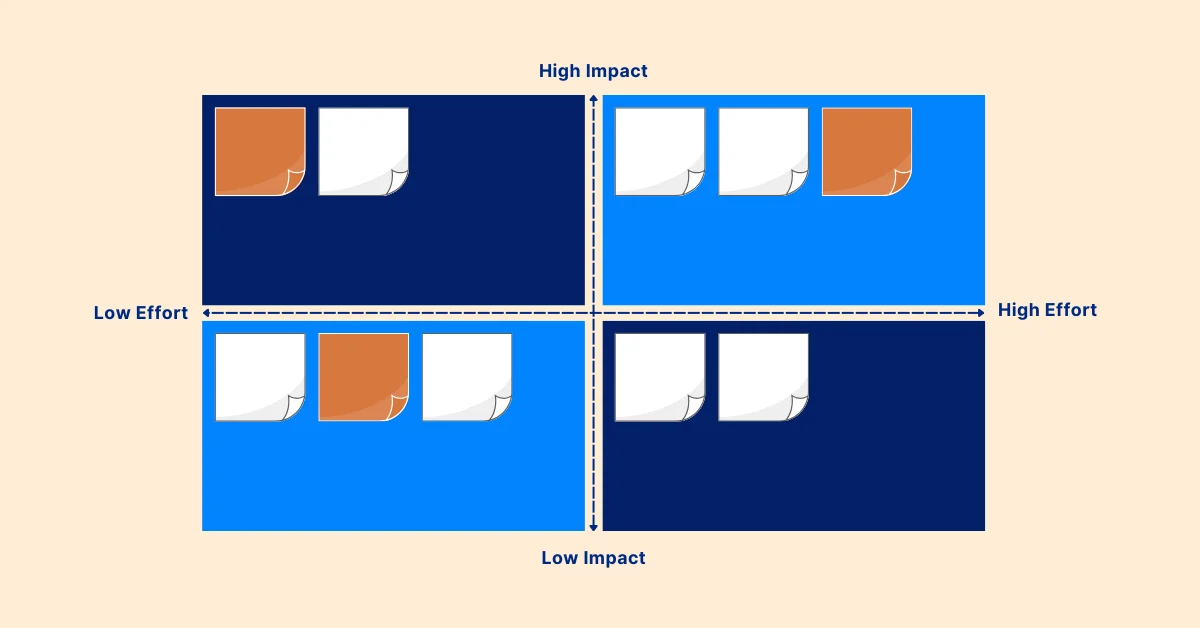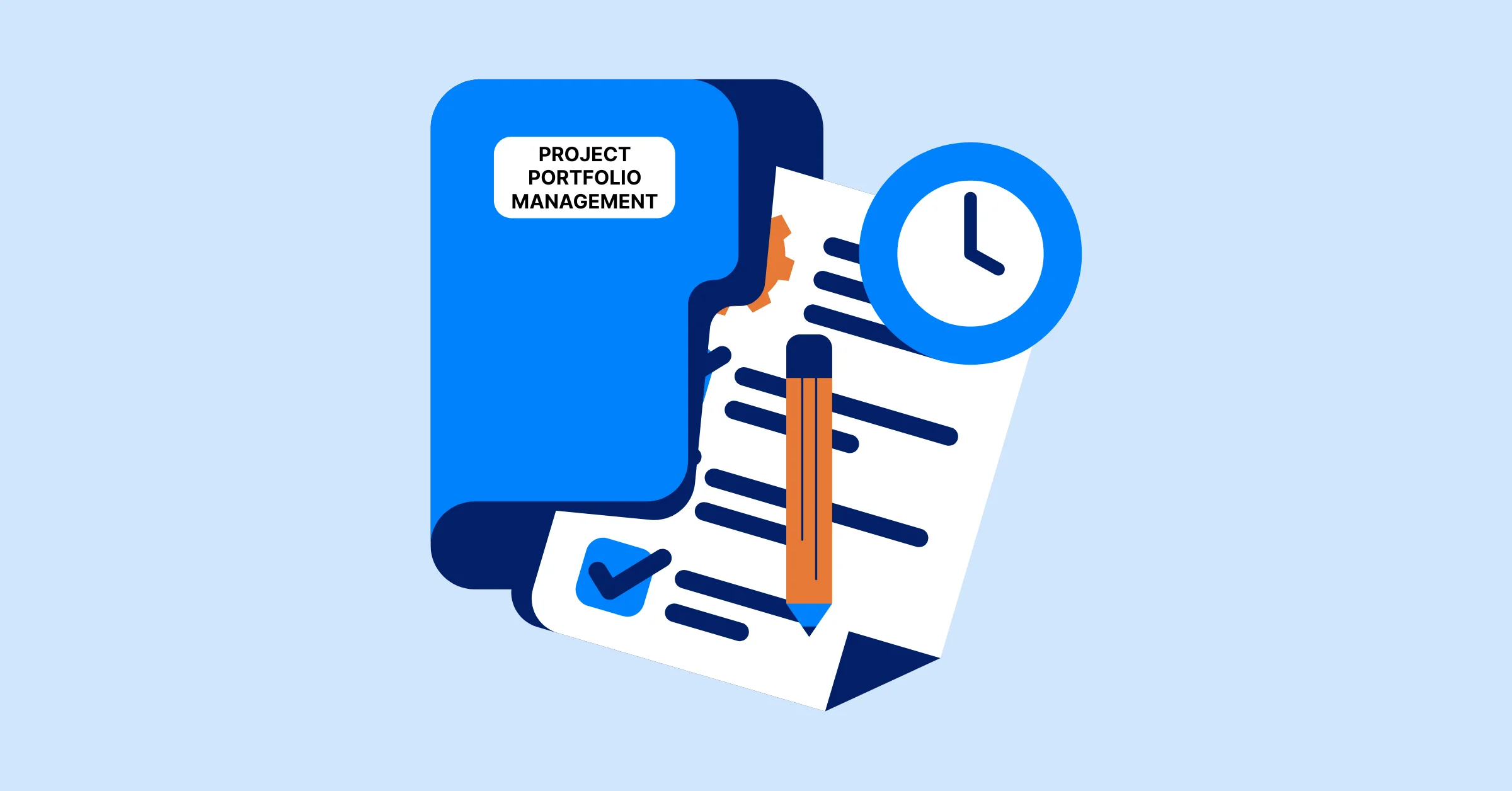How to Create a Project Communication Plan: Step-by-Step Guide [+Free Template]
Create an effective Project Communication Plan with our step-by-step guide and free template to keep your project on track, reduce risks, and enhance collaboration.
Clear, consistent communication is the secret to successful project management. Without it, projects can quickly veer off course, leading to confusion, delays, and even project failure. This is why creating a Project Communication Plan is an essential step for every project manager.
A project communication plan ensures that everyone involved in the project, whether it’s your team, stakeholders, or clients, receives the right information at the right time. It helps keep the project on track, minimizes risks, and ensures that decisions are made quickly and efficiently.
In this blog, we’ll guide you through the process of building a solid communication plan from the ground up. Plus, we’ll offer a free template to make the process even easier.
Let’s get started with the building blocks of successful project communication!
What is a Project Communication Plan? (and Why You Need One)?
A Project Communication Plan is a detailed strategy that outlines how, when, and to whom information will be communicated throughout the course of a project. It ensures that the right message reaches the right people at the right time, making it a vital tool for project success.
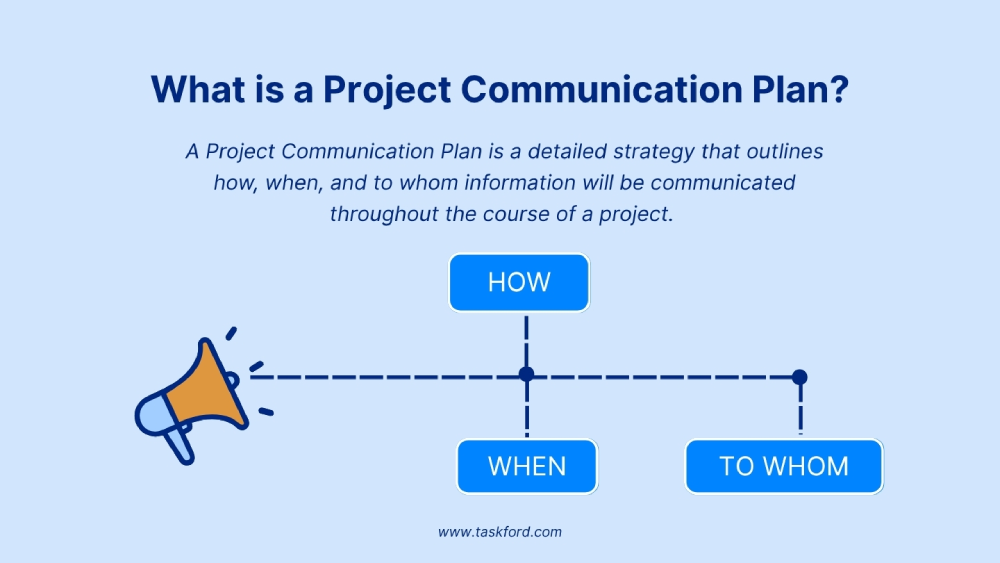
But why exactly is it so important?
Why You Need a Project Communication Plan
A Project Communication Plan is essential for keeping everyone aligned, informed, and engaged throughout the project. Here’s why you can’t afford to skip this step:
-
Mitigate Risks & Avoid Failures: A communication plan helps identify and address potential issues early on, preventing misunderstandings, delays, or costly mistakes that can derail the entire project.
-
Foster Collaboration & Build Trust: By ensuring everyone is informed and on the same page, clear communication strengthens relationships within the team and with stakeholders, promoting collaboration and trust.
-
Drive Efficiency & Boost Productivity: A well-organized communication strategy reduces unnecessary meetings and miscommunication, allowing team members to focus on tasks, streamlining workflows, and boosting overall productivity.
-
Ensure Stakeholder Alignment & Satisfaction: Tailoring your communication to meet the needs of different stakeholders keeps them engaged and ensures their expectations are aligned, ultimately leading to higher satisfaction and support.
-
Promote Accountability & Transparency: Clearly defined roles and consistent messaging help prevent misunderstandings, create accountability, and foster transparency, leading to a project environment where everyone knows their responsibilities.
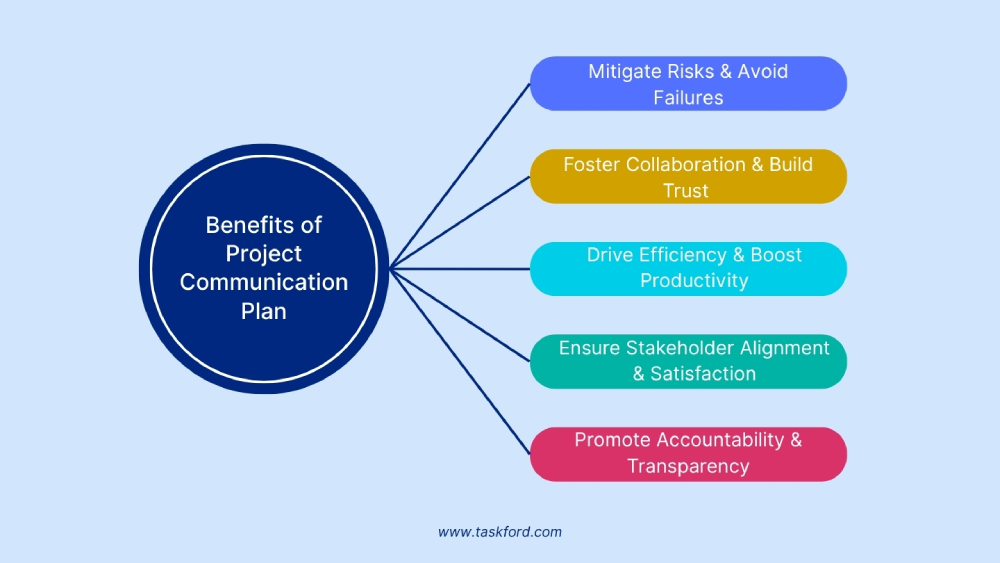
In short, a well-structured communication plan keeps your project on track, minimizes risks, and drives better outcomes.
The 6 Key Components of a Project Communication Plan
A solid Project Communication Plan is built on several key components that ensure the right messages reach the right people at the right time. Let’s explore the six essential elements that make up an effective communication strategy:
-
Communication Objectives Set clear goals for what you want to achieve with communication. This could include keeping stakeholders informed, managing risks, or facilitating team collaboration.
-
Stakeholder Identification Identify all stakeholders involved in the project, both internal and external. Understand their communication needs, preferences, and how often they need updates.
-
Communication Methods and Tools Choose the most effective communication channels and tools, such as emails, meetings, project management tools, or reports, based on the message and audience.
-
Communication Frequency and Timing Define how often communication will occur—daily, weekly, monthly—and set specific times for updates, meetings, or reports to ensure consistent information flow.
-
Roles and Responsibilities Clearly assign who is responsible for each communication task. This ensures accountability and helps prevent gaps or overlaps in communication efforts.
-
Monitoring and Feedback Regularly evaluate the effectiveness of the communication plan. Gather feedback from stakeholders and team members to improve and adjust the plan as needed.
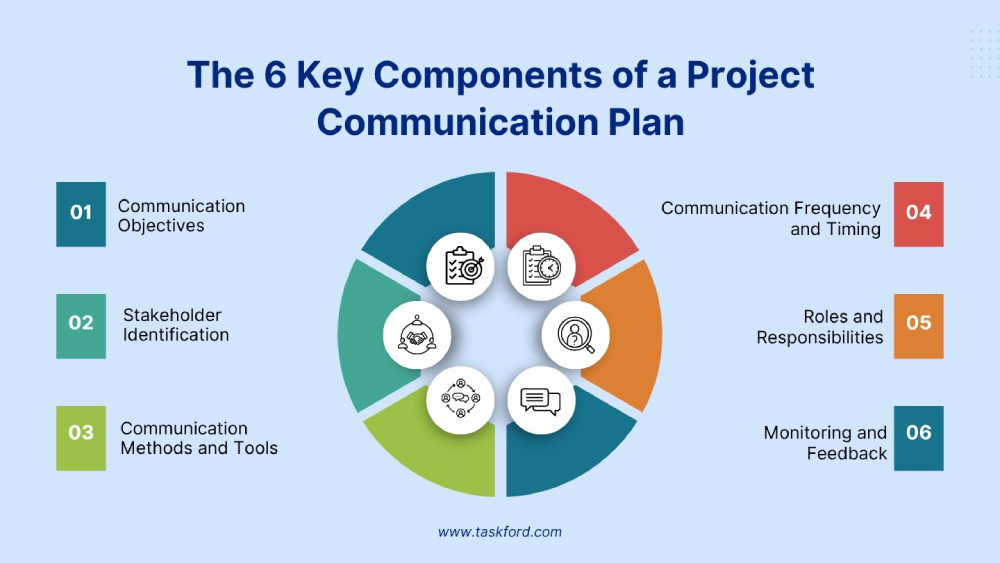
How to Create a Project Communication Plan: Step-by-Step Guide
Phase 1: Laying the Strategic Foundation
Step 1: Define SMART Project Communication Goals
Start by setting clear communication goals using the SMART framework. Make sure they are Specific, Measurable, Achievable, Relevant, and Time-bound. For example, "Ensure weekly status updates are sent to stakeholders every Friday by 3 PM."
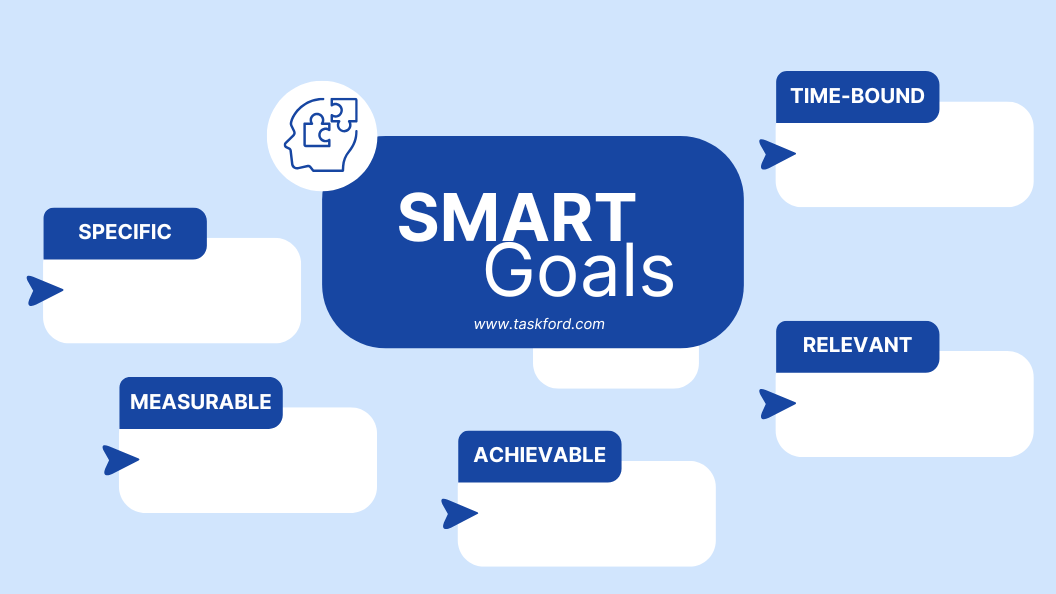
Step 2: Conduct a Comprehensive Stakeholder Analysis
Identify all the stakeholders involved in the project, both internal and external. Map out their communication needs, preferences, and expectations to ensure you know who needs what information and how often.
Step 3: Evaluate Current Organizational Communication Climate & Process
Assess the existing tools, policies, and communication channels your organization uses. Understand current pain points and gaps in communication. This will help you identify what works and what needs improvement.
Phase 2: Designing & Developing the Plan
Step 4: Determine Specific Communication Content & Detail for Each Audience
Tailor the information to different stakeholders. Determine what level of detail each group needs and how technical the content should be. For example, high-level executives may need concise summaries, while the project team might require in-depth details.
Step 5: Select Optimal Communication Channels & Tools
Choose the right communication channels and tools for each message. Will you use email, meetings, project management tools, or instant messaging? The goal is to pick the most efficient medium based on the content and audience.
Step 6: Establish a Detailed Communication Schedule & Cadence
Decide on the frequency of updates. Will it be daily check-ins, weekly reports, or monthly presentations? Create a communication calendar to ensure consistency and timely updates.
Step 7: Assign Clear Roles & Responsibilities
Assign Directly Responsible Individuals (DRIs) for each communication task. This ensures accountability and clarity on who is responsible for sending updates, conducting meetings, or creating reports.
Step 8: Design Effective Feedback Loops & Protocols
Establish a process for gathering feedback on your communication plan. This might include regular surveys or review sessions to ensure stakeholders are satisfied with the information being shared.
Phase 3: Implementation, Monitoring & Continuous Refinement
Step 9: Document, Socialize & Distribute the Communication Plan
Document the communication plan in detail and share it with all relevant stakeholders. Make sure the plan is easily accessible, and get approvals from the key decision-makers to ensure alignment.
Step 10: Execute, Monitor & Continuously Adjust the Plan
Put the plan into action, track its effectiveness, and make adjustments as needed. Monitor stakeholder feedback and engagement, and refine the communication strategy to ensure it remains effective as the project progresses.
This guide walks you through the process of creating a robust Project Communication Plan, from initial strategy to ongoing refinement. Following these steps ensures that your communication is clear, efficient, and tailored to meet the needs of all stakeholders.
Download Your Free Project Communication Plan Template
Ready to get started on your Project Communication Plan? We’ve made it easy for you with a free, customizable template to help you organize and streamline your communication efforts.
Our free template provides a clear framework to kickstart your communication planning, including:
- Project Details: Clearly define your project's name, manager, and key start and end dates.
- Project Objectives: Outline your specific communication goals to ensure every message has a purpose and aligns with your project's success.
- Comprehensive Communication Schedule: This core section allows you to detail each communication activity, specifying the Task, its Date/Time, the Owner responsible, the target Audience, and the precise Purpose of the communication. This helps establish a predictable rhythm of engagement for all your updates and meetings.
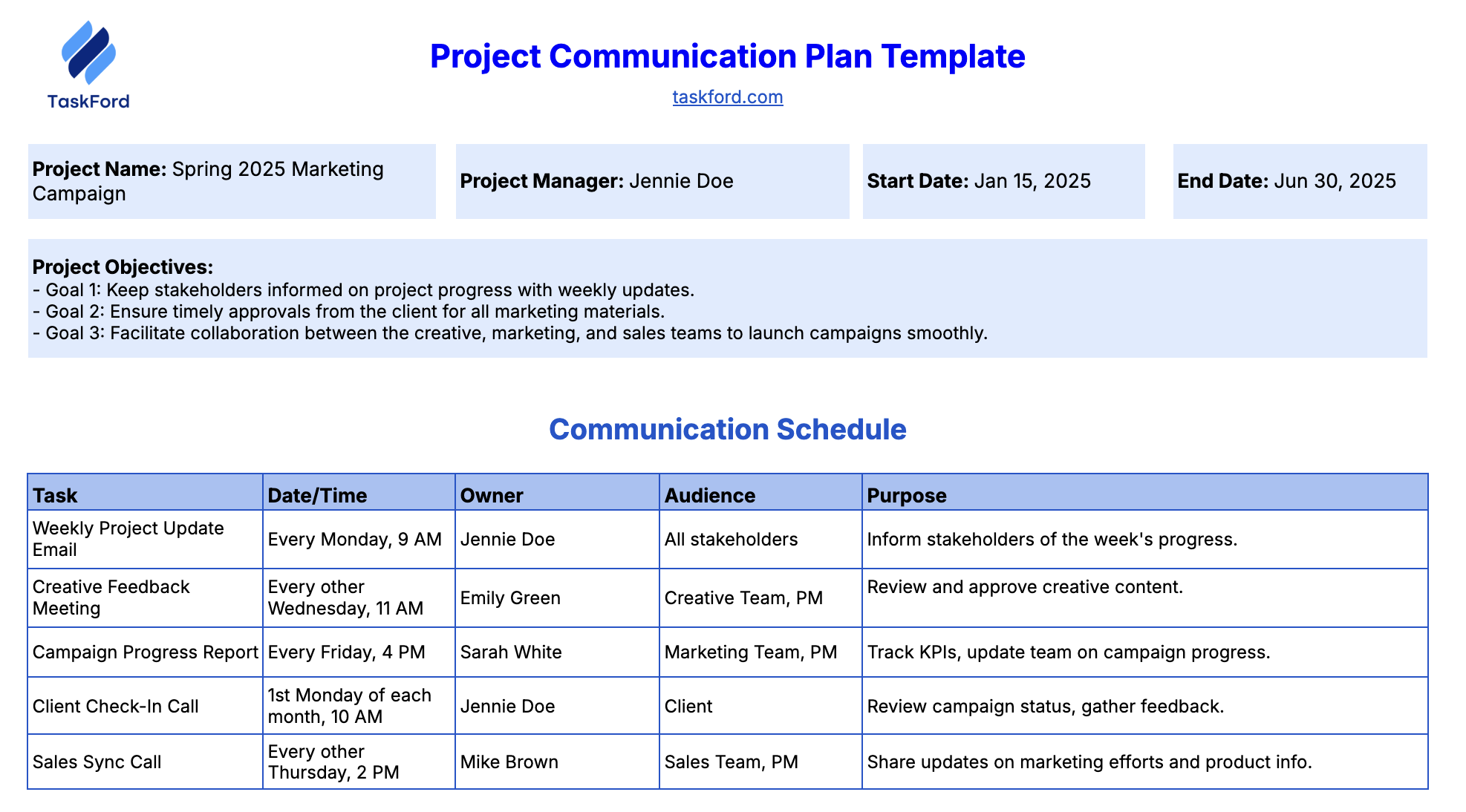
Tips for an Effective Project Communication Plan
An effective Project Communication Plan is crucial for project success! Here are some key tips for creating and implementing one, drawing from best practices:
1. Plan Strategically from the Start
-
Define SMART Goals: Before you even think about how to communicate, clearly define what you want to achieve with your communication. Make your goals Specific, Measurable, Achievable, Relevant, and Time-bound.
-
Know Your Audience (Stakeholders): Identify everyone who has an interest in or is affected by your project. Understand their roles, influence, and especially their preferred communication channels and frequency. Not everyone needs the same level of detail or the same type of update.
-
Assess Your Current Environment: Look at your organization's existing communication tools and habits. Build on what works and identify pain points to address in your plan.
2. Design for Clarity and Impact
-
Tailor Your Content: Ensure the information you share is relevant and appropriately detailed for each specific audience. Executives might need high-level summaries, while team members need granular operational details.
-
Choose the Right Channels: Don't just pick a channel because it's popular. Use interactive methods (meetings, calls) for urgent or sensitive discussions, push methods (emails, reports) for broad dissemination, and pull methods (PM software, knowledge bases) for self-service access. Match the channel to the message's nature and urgency.
-
Establish a Clear Cadence: Define when and how often communications will occur. A consistent schedule (e.g., daily stand-ups, weekly status reports) builds predictability and trust.
-
Assign Clear Ownership (DRI): For every communication task, assign a Directly Responsible Individual (DRI). This prevents confusion, ensures accountability, and avoids information falling through the cracks.
3. Foster Two-Way Communication and Adapt
-
Build Robust Feedback Loops: Communication isn't a one-way street. Actively solicit feedback through surveys, interviews, or informal check-ins. Be open to constructive criticism and use it to improve your plan.
-
Plan for Contingencies: Think ahead about potential emergencies or common objections. Have pre-defined communication protocols and templates ready to go for critical situations.
(Learn more about Contingency Planning in Project Management: How to Stay on Track When Things Don’t Go as Planned)
-
Document and Socialize: Write down your plan clearly and share it widely with all stakeholders. Make sure it's easily accessible to everyone.
-
Monitor and Adjust: Your communication plan is a living document. Continuously monitor its effectiveness, gather data (e.g., email open rates, survey responses), and be ready to adjust it as the project evolves. What works at the beginning might need tweaking later on.
By focusing on these tips, you can transform your project communication from a reactive chore into a strategic asset that drives success!
Final Thoughts
A well-crafted Project Communication Plan is a cornerstone of successful project management. By aligning communication with strategic goals, tailoring messages to the right audience, and maintaining consistent updates, you’ll foster collaboration, reduce risks, and keep your project on track.
Remember, communication isn’t a one-time task — it’s an ongoing process that requires regular review and adaptation. By following these tips and continuously refining your approach, you'll transform communication from a challenge into one of your project’s greatest strengths.
Happy planning!
Continue Reading
- What is Project Management - The Comprehensive Guide for Beginners
- Agile Project Management What is it and Why It Matters?
- Gantt Chart vs Kanban - Which one is better for your Team's Workflow
- How AI Can Help You Spot Project Risks Early - Predict Before You Panic
Making work simpler,
smarter, and more connected
Join our waitlist and be notified first.

Related Blog
Subscribe for Expert Tips
Unlock expert insights and stay ahead with TaskFord. Sign up now to receive valuable tips, strategies, and updates directly in your inbox.


